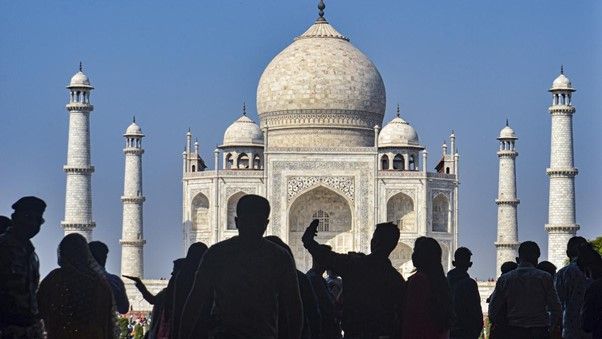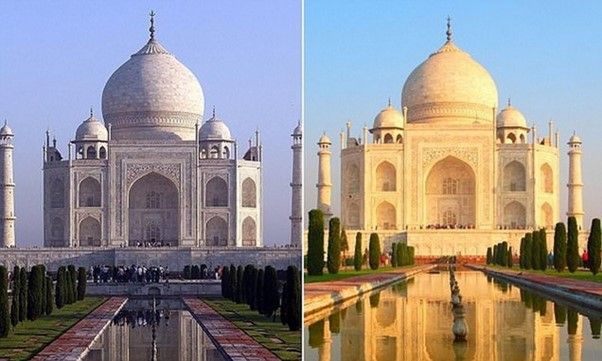Taj Mahal: The World’s Most Famous Gesture of Love
A grand proclamation of love, a world heritage site, and one of the most beautiful of the Seven Wonders of the World, the Taj Mahal is truly majestic. Built by Shah Jahan for his queen, the white marble shines bright even at night, alluring tourists and locals alike. The lesser-known religious and spiritual connotations of the palace were discovered through the exploration of its architecture, the history behind its construction, and the various talented workers who have paid with their lives to raise it to the standards it is held to today.

The Taj Mahal is located near the banks of the river Yamuna in Uttar Pradesh, Source: The Hindu
Standing tall a mere 215 kilometres away from India’s bustling capital of Delhi, on the banks of the Yamuna river, the magnificent Taj Mahal is what lends the city of Agra the old-school, rustic charm it is known for today. Wrapped in the rich Indo-Islamic history of the 17th century, the Taj Mahal was built by the Mughal ruler Shah Jahan for his most beloved queen, Begum Mumtaz Mahal.
The pomposity of the Taj Mahal gave the Mughal king the reputation of being a spendthrift, without doubt, but it also emphasised the romantic in him. The construction of the palace started in 1631 and lasted until 1643, but the entire monument was completed only in 1653. Since Mumtaz Mahal is said to have passed away a few years after her husband ascended the throne, the monument was built in her memory, establishing the great structure as a symbol of love. It is no wonder that it serves as a perfect holiday destination for lovers all around the world, including the Prince and Princess of Wales from two different generations — Charles and Diana, as well as William and Kate.
This palace not only houses her tomb but is an amalgamation of great architecture and the delicately inscribed verses of the Holy Quran. While many visitors are aware that the palace consists of the central tomb and the mosque, it is a lesser-known fact that the great gateway, a lavish guest house, as well as its lively garden, are also considered to be part of the monument despite being added on much later. However, it is the fact that the same location used to be a temple dedicated to the Hindu god Shiva that takes several visitors by surprise. When looked at from a political point of view, it very well reflects the clash of religions that was prominent among the Hindus and Muslims during Shah Jahan’s reign.
The intricacy of the monument can be attributed to several aspects. First, not a single drop of cement was used in its construction. It is, in fact, popular for being carved out of one of the world's finest marbles. The variation used here is said to be ivory-white and extracted from the mines of Makrana in Rajasthan. However, this material is focused only on the centre of the monument, i.e., the tomb. The rest of the architecture has been carved out of red sandstone, including the turrets and the domes. In fact, the base of the construction is dependent on the sandstone, while its outer portions have been covered by marble. Other than that, the backlit quartzite crystal used in its construction comes all the way from Brazil to further increase the extravagance of the palace. While the materials used may make it look dainty and delicate, the sturdiness of the monument, which is owed to its materials and the fine quality of construction, has been able to withstand the wear and tear of several centuries.
The layout of the entire monument is a blend of nature, faith, and hospitality. What most visitors will see when they first approach the monument is the grand gateway. With verses from the Holy Quran inscribed beautifully on its pillars, it stands at 30 metres in height, inviting tourists to enter the courtyard. The mosque is perhaps the most popularly visited part of the Taj Mahal after the tomb. Facing the west towards the holy city of Mecca, it is said to have been constructed by Isa Muhammad. Its portal-like exterior, called the iwan, further helps in accentuating its design. The 569 prayer mats made out of black marble and the minbar leading to the elevated platform for the maulana are all integral parts of the mosque.
The garden surrounding the Taj Mahal carries a lot of spiritual value. It is supposed to mimic the Garden of Paradise mentioned in the Holy Quran. Spread across 300 square metres, this massive garden has sixteen flower beds divided by waterways. The garden is not the only part of the Taj Mahal that carries spiritual significance, but the central structure, the tomb, is filled with them. For starters, it is based on the Islamic structure, which symbolises the unification of heaven and earth. The name of Ar-Rahman, or god, is engraved on the minars supporting the dome. It is said that the dome is designed in such a manner that it does not fall on top of the tomb in case of any natural disasters. The tomb has a central chamber as well as four other chambers below it for other family members, and it covers a vast area of 95 square metres. Among others, silver lamps, silver engravings, and screens covered with precious gemstones furnish the tomb area. As one of Shah Jahan’s largest expenditures, the monument, if made today, would cost around a whopping 70 billion Indian rupees, while it is estimated to have been within a budget of 42 million rupees in 1632.
There is no doubt that such a complex structure required several talented workers to participate in its creation. Estimated at 22,000, the workers — including the stone-cutters, artisans, carvers, painters, calligraphers, dome builders, and even the masons — were brought in from Iran and Central Asia. While there have been many rumours in circulation, stating that the emperor cut off the hands of the creators after the Taj Mahal was complete, there has been no concrete proof of the said incident. Yet, there has been no other architecture that has been carved with such expertise that it is hard not to believe the floating rumours. However, people have been said to have lost their lives in the process of its creation, but an accurate number has not been discovered. Despite these controversies, it has popularised Ustad Ahmad Lahori, the architect and designer of the monument, and made him go down in history as a mastermind.
Owing to its historical significance, this mausoleum was added to the list of UNESCO World Heritage Sites in 1982 and is also considered to be part of the modern Seven Wonders of the World. With more than 8 billion people visiting the Taj Mahal annually, it serves as a great source of tourism for the government of India. For such visitors, the site is open for viewing every day, including Sundays and excluding Fridays. The gates usually open half an hour before sunrise and close half an hour after sunset. The ticket also varies according to the type of visitor. This means that foreign tourists are taxed a little higher, ranging between 200 and 1100 rupees per visit, as compared to locals, who pay 200 to 540 rupees for the same. The revenue brought in by these tourists is extremely valuable, but popularity does not come without a cost. Several scandals and controversies have surrounded the heritage site before, including hauntings by the ghost of the begum, sometimes the shah himself, and sometimes the workers who died while building it. Of course, there is no factual evidence of it.
A certain man known by the name of ‘Natwarlal’, who is said to partake in several high-profile crimes, is said to have found a way to con people into believing the Taj Mahal could be bought. The lack of information in the 1900s as well as the vulnerability of people led him to sell the Taj Mahal not once, not twice, but three times! Similarly, there have been hundreds who are still misinformed that the Taj Mahal is a palace whose ownership can be changed. To prevent such incidents from happening again, the Indian Archeological Survey has taken it upon themselves to be responsible for the preservation and legal protection of the monument. Through the establishment of the Ancient Monument and Archaeological Sites and Remains Act of 1958 and the Rules of the 1959 Ancient Monuments and Archaeological Sites and Remains Act, several legal frameworks have been set up to guarantee their safety.
Although the government branches may be able to protect the Taj Mahal from being sold by crooks again, they have not been able to prevent the natural erosion of the palace. With several effects of the begrudged acid rain showing up, from the chipping of the marble to its catalysed yellowing in the past decade, global climate change has certainly been unkind to the grand monument as well. With the air pollution only getting worse in Northern India, especially in states like Uttar Pradesh and Bihar, people need to start becoming more wary of their day-to-day decisions and how they affect historical monuments like the Taj Mahal.
Today, the word 'Taj’ itself carries a kind of brand value other companies couldn’t dare reach. The blend of architecture, its strategic location, and the spiritual and religious connotations it carries make it one of the favourite destinations for holidays for foreigners and domestic travellers alike. While many leave with cameras filled with photographs of the monument, others take away small keychains and figurines to keep at home. If the right course of action is not taken now, it is certain that the same pictures and mini-replicas will be all that is left of it in the coming years.

The yellowing of the Taj Mahal has been so severe that it is visible to the naked eye today, Source: Rethinking The Future


